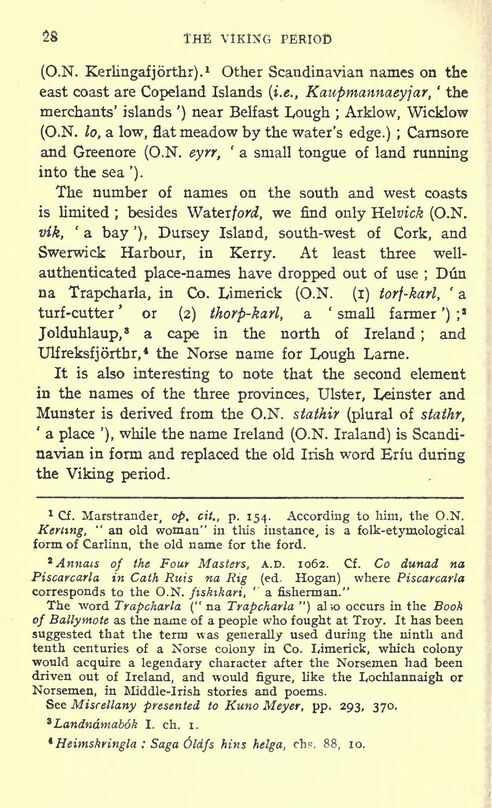
Full resolution (JPEG) - On this page / på denna sida - III. The Growth of the Seaport Towns

<< prev. page << föreg. sida << >> nästa sida >> next page >>
Below is the raw OCR text
from the above scanned image.
Do you see an error? Proofread the page now!
Här nedan syns maskintolkade texten från faksimilbilden ovan.
Ser du något fel? Korrekturläs sidan nu!
This page has never been proofread. / Denna sida har aldrig korrekturlästs.
28 THE VlKltfG PERIOD
(O.N. Kerlingafjb’rthr).
1
Other Scandinavian names on the
east coast are Copeland Islands (i.e., Kaupmannaeyfar,
’
the
merchants’ islands ’)
near Belfast Lough ; Arklow, Wicklow
(O.N. lo, a low, flat meadow by the water’s edge.) ; Carnsore
and Greenore (O.N. eyrr,
’
a small tongue of land running
into the sea ’).
The number of names on the south and west coasts
is limited ; besides Water/on*, we find only Heluic^ (O.N.
vik,
’
a bay ’), Dursey Island, south-west of Cork, and
Swerwick Harbour, in Kerry. At least three well-
authenticated place-names have dropped out of use ; Dun
na Trapcharla, in Co. Limerick (O.N. (i) torf-karl,
’
a
turf-cutter’ or (2) thorp-karl, a ’small farmer’);*
Jolduhlaup,
8
a cape in the north of Ireland ; and
Ulfreksfjorthr,’ the Norse name for Lough Larne.
It is also interesting to note that the second element
in the names of the three provinces, Ulster, Leinster and
Munster is derived from the O.N. stathir (plural of stathr,
’
a place ’), while the name Ireland (O.N. Iraland) is Scandi-
navian in form and replaced the old Irish word Eriu during
the Viking period.
1
Cf. Marstrander, op. cit., p. 154. According to him, the O.N.
Kening,
"
an old woman" in this instance, is a folk-etymological
form of Carlinn, the old name for the ford.
2
Annais of the Four Masters, A.D. 1062. Cf. Co dunad na
Piscarcarla in Cath Ruts na Rig (ed. Hogan) where Piscarcaria
corresponds to the O.N. fiskikari,
"
a fisherman."
The word Trapcharla (" na Trapcharla ") al;o occurs in the Book
of Ballymote as the name of a people who fought at Troy. It has been
suggested that the term was generally used during the ninth and
tenth centuries of a Norse colony in Co. Limerick, which colony
would acquire a legendary character after the Norsemen had been
driven out of Ireland, and would figure, like the Lochlannaigh or
Norsemen, in Middle-Irish stories and poems.
See Miscellany presented to Kuno Meyer, pp. 293, 370.
9
Landndmabok I. ch. i.
’
Heimskringla :
Saga 6ldfs hins helga, ch?. 88, 10.
<< prev. page << föreg. sida << >> nästa sida >> next page >>